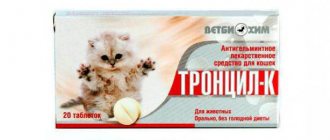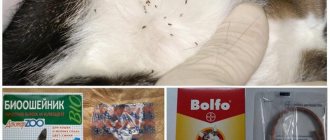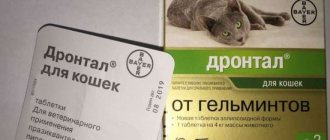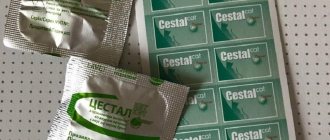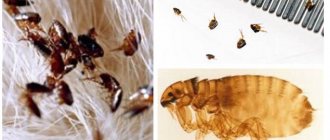Content
1. General description 2. Composition and action 3. Purpose 4. Dosage 5. Limitations and possible negative consequences 6. Analogues and price 7. Reviews
Otodectin for cats is a modern and effective antiparasitic drug that simultaneously destroys both intestinal parasites and insects that settle on the skin of pets. The main advantages of the drug are its rapid action and high effectiveness, and veterinarians note its low toxicity.
Composition and action
The main component of the drug is ivermectin. This is a substance of natural origin that has a pronounced antiparasitic effect. The advantage of ivermectin is its activity against both internal and subcutaneous parasites in cats, which reduces the dose of toxic substances that enter the animal’s body if a standard two-stage treatment is carried out - first against fleas and ticks, then against worms.
Ivermectin, penetrating the parasite's body, causes a blockage of nerve impulses, which causes paralysis and then the rapid death of the parasite. The effectiveness of the drug is evidenced by the fact that one or two injections are enough to completely rid your pet of worms (roundworms) and fleas. Ivermectin is active against both mature individuals and their larvae. The drug is used for infection with subcutaneous, nasopharyngeal, and intestinal parasites. After subcutaneous administration, the drug begins to act within an hour and remains effective for 10-14 days.
Important!
Otodectin is a low-toxic drug; symptoms of poisoning can be observed with severe infection and simultaneous mass death of parasites.
Important instructions
If the parasitic infection is accompanied by a bacterial infection, then additional use of antibacterial agents and acaricidal agents for external use is recommended. When getting rid of fleas and lice, simultaneously with the use of the drug, the litter, floor and other possible breeding sites for parasitic insects are treated.
A slight infiltrate may form at the injection site immediately after the injection, which disappears on its own even without special treatment. No special side effects were identified during the first use (as opposed to subsequent ones). Special attention and medical supervision should be shown to animals that have weakened liver and kidney function, because they are highly likely to develop a toxic effect.
The drug can be stored at a temperature not exceeding 30 ° C, away from direct sunlight, flame, food and children. The shelf life of the medicine is 5 years from the date of production. After the expiration date, it must be disposed of in accordance with the rules for the disposal of highly hazardous substances.
If the solution gets on the skin or mucous membranes, immediately remove it with a cotton swab and rinse this part of the body with plenty of water. If an allergic reaction occurs, immediately seek help from a medical facility, and if this is not possible, take an antihistamine (Suprastin, Loratadine, etc.).
READ Scary cat breeds
Purpose
Otodectin, like any medical or veterinary drug, cannot be used for self-medication. The drug is prescribed by a veterinarian for the following types of infestations.
Otodectosis is also known as ear scabies. The microscopic parasite penetrates the cat's ear, makes passages under the skin in the ear canal, and is most active at night. The tick is constantly moving, which causes discomfort in the animal. The insect feeds on pieces of skin, and the mite waste gets into the microscopic wounds that form. There they rot and cause inflammation. Without treatment, the inflammation develops further and can invade the inner parts of the ear and affect the lining of the brain, which will lead to the rapid death of the animal.
Demodicosis is a disease caused by infection with skin parasites - mites that settle on the cat’s body and form microchannels under the skin. The tick's movements throughout the animal's body, as well as its waste products, cause itching, and the pet scratches its body until there are wounds and blood. These wounds serve as open gates for pathogenic bacteria and viruses to enter the body. Advanced infection may be complicated by secondary bacterial infection.
Ticks of the genus Notoedres cati parasitize the skin of pets, but also pose a danger to humans. When a cat is infected, lesions are visible on the body, most often they are localized on the forehead, ears, bridge of the nose, and head. In these places you can observe nodules, blisters, and areas of baldness.
Another type of mite, sarcoptoid mite, causes scabies. Even from the name you can understand that the main manifestation of the disease is severe itching. The cat becomes nervous, a rash appears on its body, and the areas where it was scratched become covered with scales. The appearance of the coat deteriorates, it becomes dull, and bald patches form in areas where it has been scratched.
No less dangerous than ticks and fleas are internal parasites. Settling in the cat’s intestines, they disrupt its microflora and cause inflammation. If the infection is severe, other internal organs may be affected. The waste products of worms cause severe intoxication of the body, and with a large number of parasites there is a risk of intestinal blockage, which will cause the death of the pet.
If you suspect a helminthic infestation or mite infestation, you should take your cat to a veterinarian as soon as possible. Using tests and laboratory tests of skin scrapings (if infected with mites), he will determine the type of causative agent of the disease and select the most effective and safe drug. Along with Otodectin, medications are usually prescribed that will support the functioning of the liver, which is under increased stress due to the massive death of parasites. Vitamin and mineral complexes will help support the immune system.
Otodectin: instructions for use for cats
According to the instructions, Otodectin is administered through a syringe with a short needle subcutaneously into the forearm or shoulder joint of the cat. The dosage is calculated based on the weight of the animal: per 1 kg of weight - 0.2 ml of the drug.
For treatment against helminths, one dose of the medicine is enough, but for ticks and fleas - twice with an interval of 8 to 10 days. It is also necessary to treat the floor and bedding.
You should be very careful when treating Otodectin and avoid overdoses.
During treatment of the cat, it is necessary to observe aseptic measures, do not eat or smoke. If an allergic reaction to the drug occurs or if it accidentally enters the human body, immediately seek help from a specialist.
In veterinary medicine, the drug Otodectin is prescribed for the treatment of diseases caused by parasites in cats:
- Otodectosis;
- Sarcoptic mange;
- Demodectic mange;
- Nematodosis;
- Psoroptosis;
- Notoedrosis;
- When pets are infected with lice, fleas, lice eaters.
Otodectosis
Ear mite. It affects the skin of the inner surface of the ear and the eardrum. With otodectosis, the animal is bothered by severe itching in the ear. If you do not seek help from a veterinarian in time, the disease can be complicated by purulent otitis media (due to severe itching, the animal scratches its ears, thereby contaminating them. Inflammation can spread to the inner ear, and later to the outer membranes of the brain, and this is already is fraught with the death of the pet), dermatitis.
The disease is transmitted through contact with other sick animals, rodents, and insects. Or the pathogens are carried on clothes/shoes. The greatest activity of the disease is observed in the cold season, or with a sharp change in air temperature.
Sarcoptic mange
Or pruritic scabies - infestation with mites. Covers the entire body, starting from the muzzle, wings of the nose, and forehead. Later, the entire body becomes covered with bald patches, scabs, and scabs. The disease causes severe itching - the pet becomes restless, sleeps poorly, loses interest in food, and may experience nervous and physical exhaustion.
It is believed that the main sources of the disease are infected animals kept together with healthy ones. But this type of scabies is very insidious: it is possible to catch this mite even if the cat simply lies down in the place where an infected fellow rested before her. Therefore, if your animal is free-ranging, then it is at risk.
Demodicosis
Subcutaneous mite. Its peculiarity is that it can be present in the animal’s body constantly, but not manifest itself in any way. But as soon as the immune system weakens, it makes itself felt. Affects the skin and hair of the animal.
Demodicosis is a dangerous disease that can be inherited. Therefore, it is recommended to sterilize recovered animals and prevent them from reproducing.
The main symptoms of demodicosis:
- Redness of the skin;
- Deterioration in the appearance of fur, its loss;
- The appearance of flaky skin around the eyes (“demodicosis glasses”), on the head, neck, ears, and in more severe forms - on the paws and body of the animal;
- Severe itching;
- Skin pigmentation disorder;
- The appearance of bleeding wounds (due to severe itching, the animal often itches, thereby causing microtrauma to the skin, which begins to bleed).
Nematodosis
Nematodosis (toxocariasis, toxascariasis) is a parasitic disease in cats caused by nematodes - roundworms (worms). Nematodes parasitize the small intestine of an animal.
Infection most often occurs when it enters the body:
- Nematode eggs - with food or water;
- Adults - when a cat eats raw meat infested with worm larvae;
- In utero (small kittens).
In sick animals, the appetite deteriorates, the pet loses a lot of weight, while its stomach becomes large and hard “like a drum”, the stomach is painful on palpation, and digestive disorders often begin to bother them: diarrhea or constipation. The animal's gait becomes unsteady, and small kittens are stunted in growth.
READ Raising Siamese cats
Psoroptosis
Cutaneous scabies. A chronic disease that spreads quickly. Infection occurs through contact of infected animals with healthy ones, as well as through care items, or transferred on human clothing and shoes. Most often, the disease spreads in autumn-winter (when there is increased moisture in the skin and fur of animals).
Symptoms:
- Severe itching (usually at night);
- The skin on the itchy areas is inflamed and lymph begins to flow;
- Hair loss from the affected areas, the body becomes covered with yellow crusts;
- Apathy, loss of appetite, development of exhaustion. If you do not seek help from a veterinarian in time, death is possible.
Notoedrosis
A chronic disease caused by the sarcoptoid mite. In this case, the skin becomes inflamed and hair falls out on the animal’s head, accompanied by severe itching and, as a result, scratching.
Even a short interaction with an animal suffering from notoedrosis is enough for the disease to be transmitted to a healthy pet. In addition, the tick can be carried on clothing, shoes, and household items.
Most often, young cats suffer from this disease. Initially, the tick infects areas near the animal's nose, base of the ears and near the eyes. The affected areas begin to itch very much, causing the animal to itch a lot, thereby spreading the parasites to other parts of the body: stomach, paws, chest. The skin in these places becomes thicker and crusts form on it, which crack over time.
This is the most common disease in pets: every owner of a furry pet has probably encountered it. These small blood-sucking creatures can cause many unpleasant moments for both the pet and its owners. They call:
- Severe itching, which can lead to scratching and hair loss;
- The appearance of dermatitis (the same “flea dermatitis”);
This is a serious problem because these parasites can also lead to helminth infections. And in small kittens they cause anemia, which leads to sad consequences.
These parasites enter animals from the external environment.
Otodectin is an antiparasitic drug. It is a colorless transparent liquid. The main active ingredient of the drug is ivermectin, with a concentration of 1 mg/ml solution. As excipients - isopropanol, triethylene glycol.
Dosage form: solution for injection.
The drug has a paralyzing effect on:
- Nematodes;
- Sarcoptoid mites;
- Demodectic mites;
- Insects that parasitize carnivores.
After introducing the drug into the pet’s body, ivermectin is absorbed and distributed throughout the animal’s organs and tissues. The antiparasitic effect lasts up to ten days - two weeks.
The drug is low toxic for cats. At the recommended dosage, Otodectin is harmless.
According to the instructions, the drug is injected subcutaneously into the withers. The dosage is calculated taking into account the weight of the animal (it is better for a veterinarian to do this). For deworming, a single use of the drug is sufficient; for treatment against fleas and ticks, revaccination is required after two weeks (ten days). Despite good reviews from cat owners, the instructions do not recommend the use of the drug:
- Kittens less than 8 weeks old;
- Exhausted animals;
- In the postoperative period or during infectious diseases;
- During pregnancy and immediately after childbirth.
The price of the drug is from 65 rubles per bottle (depending on the dosage).
I have two cats that roam freely on the street (I live in a private sector). Not long ago I noticed that one of them was constantly shaking her head and scratching her ear. I rushed to the veterinarian, and they discovered otodectosis (ear mites). Otodectin was prescribed twice with an interval of 14 days. It was necessary to stab at the withers, so I did it myself - the cat did not resist. And now my darling is healthy!
Inna, Ukraine
I went to the dacha for the summer with a cat, the cat went crazy with freedom - he walked, rarely showed up home. Then he appeared, but he looked strange - bald in places, with some kind of scabs. Let's go to the doctor. We found a tick on my Masik. They told me to inject Otodectin every 10 days, three times in total. The cat was not particularly happy about the procedure, of course, but he was cured - he grew fur again and became cheerful.
Semyon, Krasnodar
Otodectin is not taken for preventive purposes, so only a veterinarian can prescribe the drug after identifying the type of pathogenic parasite.
Important! The antiparasitic drug should be used only under the supervision of a veterinarian, strictly following the dosage and dosage regimen.
| Types of infection | Dosage |
| for the treatment of helminthic infestations | once 0.2 ml/kg |
| getting rid of ectoparasites (fleas, ticks, lice eaters) | twice 0.2 ml/kg (interval – 8-10 days) |
For accelerated treatment, additional use of antibacterial agents and veterinary medications to strengthen the immune system is recommended.
Disinsection of bedding, carpets and insect breeding sites is mandatory during and after treatment.
Dosage
Otodectin is sold in veterinary pharmacies in the form of a ready-to-use injection solution. The injections are given subcutaneously. To do this, you should prepare a syringe with medicine, fix the cat, pull back the skin on the withers and inject the medicine, holding the syringe with the needle at a right angle to the animal’s body. The dose of the drug is determined by the amount of active substance per animal’s body weight and is 200 mcg of ivermectin per 1 kg of cat’s weight. In terms of solution, this is 0.2 ml/1 kg.
In most cases, one injection is enough to get rid of worms; in case of severe infestation, a second injection may be required after a week. Treatment against ticks and other ectoparasites is carried out twice, with an interval between injections of 8-10 days.
Limitations and possible negative consequences
In the practice of veterinarians, cases of complications after the use of Otodectin are extremely rare; they are usually associated with exceeding the dose or violating restrictions. You cannot give injections:
- kittens under 2 months of age;
- exhausted animals;
- patients with infectious diseases;
- those suffering from oncology;
- in the postoperative period;
- pregnant and lactating cats.
Otodectin causes an individual hypersensitivity reaction in some animals, so the animal should be monitored after injection. To avoid serious complications, it is recommended that the injection be done at a veterinary clinic.
In case of an overdose, a cat may experience lethargy, depression, ataxia, sometimes vomiting and diarrhea, refusal to eat, tremors, and increased urination. If these symptoms do not go away within 24 hours, you should take your pet to the veterinarian.
Contraindications and precautions
According to clinical studies, Otodectin is a low-risk drug for animals if you do not independently treat a sick pet. In case of overdose, the following violations are possible:
- Frequent urination.
- Frequent bowel movements.
- Tremor.
- Increased salivation.
If you use the drug according to the instructions, according to the basic rules, then side effects will not appear. The use of Otodectin is contraindicated in the following cases:
- Hypersensitivity to components in animals.
- Severe exhaustion of the animal.
- Infectious diseases.
In the presence of infections or exhaustion, treatment with injections is possible, but for this the animal must be examined and diagnosed by a doctor.
Otodectin is included in the group of low-hazard drugs (hazard class 4). But its active substance in its pure form is classified as extremely dangerous (class 1). Therefore, overdose can lead to serious side effects. When using the medicine in accordance with the instructions and under the supervision of a veterinarian, there is nothing to be afraid of - in recommended dosages it does not harm the cat’s body.
involuntary muscle contractions and trembling of the limbs; increased production of saliva; ataxia - loss of coordination of movements; frequent bowel movements and urination. Otodectin is never used in conjunction with another drug, the active ingredient of which is ivermectin. If a cat has an individual intolerance to the medicine, then swelling and mild pain appear at the injection site. These symptoms usually go away within 4 days, and the doctor prescribes an antihistamine.
READ Rottweiler Extreme Vom Edelshtein on SOBAKA.LV
Otodectosis. Ear mites in cats.
Although Otodexin for cats is a drug that cannot cause harm to their body, the active ingredient Ivermectin in the drug is not suitable for all cats. That is why it is very important not to self-medicate, but to use the drug only as prescribed by a veterinarian and only after carefully reading the instructions for use for cats.
Otodexin is contraindicated for:
- Kittens less than two months old;
- Cats with individual intolerance to ivermectin or additional components of the drug;
- Exhausted cats;
- Cats suffering from infectious diseases at the time of taking the medicine.
There are no serious side effects, but with an overdose of the drug there were
- Frequent bowel movements and urination;
- Tremor of the limbs and even the whole body;
- Ataxia (motility disorder);
- Profuse drooling.
If an allergic reaction occurs to any of the components of the drug, you must take a strong antihistamine.
It is important to remember that taking Otodectin simultaneously with other drugs containing ivermectin is prohibited.
Analogs and price
The market for antiparasitic veterinary drugs is quite wide. You can also find other medications with ivermectin as an active ingredient. These are Ivermek, Ivertin and others. In addition, if you are allergic to ivermectin, your veterinarian may recommend other broad-spectrum antiparasitic medications.
The drug is in demand among pet owners due to its high effectiveness at an affordable price. The cost of 1 bottle of Otodectin (5 ml) is 70-80 rubles.
